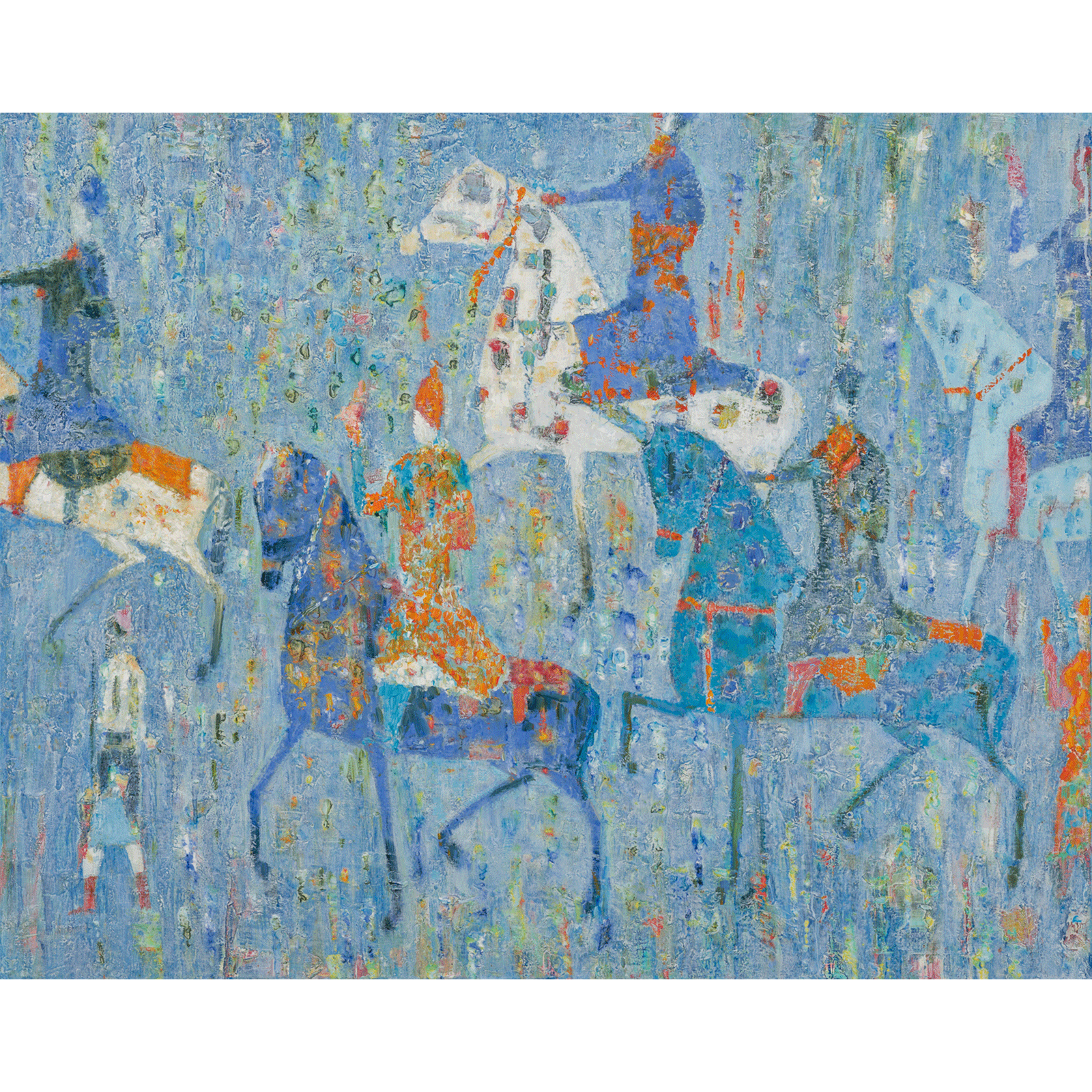2020 Fine Sporting Art, American Paintings, and Sculpture
172| Reza Derakshani (Iranian, b. 1952)
After Rain Hunt
An immigrant and a wanderer, Reza Derakshani repurposes the major themes of Persian poetry and miniatures ? history and myths, mysticism, romantic subjects, elegy and panegyric, truth and wisdom ? into his work to connect Eastern culture to Western and ultimately give his viewer an overall idea of the experience of the migrant. Using lover kings and queens, the rose and the nightingale, the hunt and the empty pages provided by abstract color fields, the artist addresses these same issues but in the context of our time. In his paintings, linguistic barriers disappear, and the world of Iranian miniatures converses with the global idiom of painting.
Viewed from the side as in traditional Persian book illustrations and with historical connotations, Derakshani?s works point to the essential importance of figure depictions as carriers of meaning. Layered with musical references that speak to the artist?s other passion, composing, his pictures of the hunt translate the musical element of tema con variazioni into abstract painting. The theme with variations exposes the central theme of a melody by successively adding variants in its tonality and melodic structures. By moving away from, and sometimes even distorting the main theme in its original structure, the listener arrives at new conclusions about the original melody. Abstract expressionism provides a vehicle through which Derakshani could translate this musical element into his art. He was particularly inspired by the movement during the 16 years he spent in New York after fleeing his native Iran due to the fall of the Shah in 1979. Incorporating the practices of the abstract expressionists into his art allowed the artist to reconcile East with West and address the feelings of insecurity, isolation, and disassociation he felt as a migrant forced from his homeland.
Oil on canvas, 32" x 40"
$30000. - $40000.
An immigrant and a wanderer, Reza Derakshani repurposes the major themes of Persian poetry and miniatures ? history and myths, mysticism, romantic subjects, elegy and panegyric, truth and wisdom ? into his work to connect Eastern culture to Western and ultimately give his viewer an overall idea of the experience of the migrant. Using lover kings and queens, the rose and the nightingale, the hunt and the empty pages provided by abstract color fields, the artist addresses these same issues but in the context of our time. In his paintings, linguistic barriers disappear, and the world of Iranian miniatures converses with the global idiom of painting. Viewed from the side as in traditional Persian book illustrations and with historical connotations, Derakshani?s works point to the essential importance of figure depictions as carriers of meaning. Layered with musical references that speak to the artist?s other passion, composing, his pictures of the hunt translate the musical element of tema con variazioni into abstract painting. The theme with variations exposes the central theme of a melody by successively adding variants in its tonality and melodic structures. By moving away from, and sometimes even distorting the main theme in its original structure, the listener arrives at new conclusions about the original melody. Abstract expressionism provides a vehicle through which Derakshani could translate this musical element into his art. He was particularly inspired by the movement during the 16 years he spent in New York after fleeing his native Iran due to the fall of the Shah in 1979. Incorporating the practices of the abstract expressionists into his art allowed the artist to reconcile East with West and address the feelings of insecurity, isolation, and disassociation he felt as a migrant forced from his homeland.
An immigrant and a wanderer, Reza Derakshani repurposes the major themes of Persian poetry and miniatures ? history and myths, mysticism, romantic subjects, elegy and panegyric, truth and wisdom ? into his work to connect Eastern culture to Western and ultimately give his viewer an overall idea of the experience of the migrant. Using lover kings and queens, the rose and the nightingale, the hunt and the empty pages provided by abstract color fields, the artist addresses these same issues but in the context of our time. In his paintings, linguistic barriers disappear, and the world of Iranian miniatures converses with the global idiom of painting. Viewed from the side as in traditional Persian book illustrations and with historical connotations, Derakshani?s works point to the essential importance of figure depictions as carriers of meaning. Layered with musical references that speak to the artist?s other passion, composing, his pictures of the hunt translate the musical element of tema con variazioni into abstract painting. The theme with variations exposes the central theme of a melody by successively adding variants in its tonality and melodic structures. By moving away from, and sometimes even distorting the main theme in its original structure, the listener arrives at new conclusions about the original melody. Abstract expressionism provides a vehicle through which Derakshani could translate this musical element into his art. He was particularly inspired by the movement during the 16 years he spent in New York after fleeing his native Iran due to the fall of the Shah in 1979. Incorporating the practices of the abstract expressionists into his art allowed the artist to reconcile East with West and address the feelings of insecurity, isolation, and disassociation he felt as a migrant forced from his homeland.
To Leave An Absentee Bid, Please Enter An Amount Below

